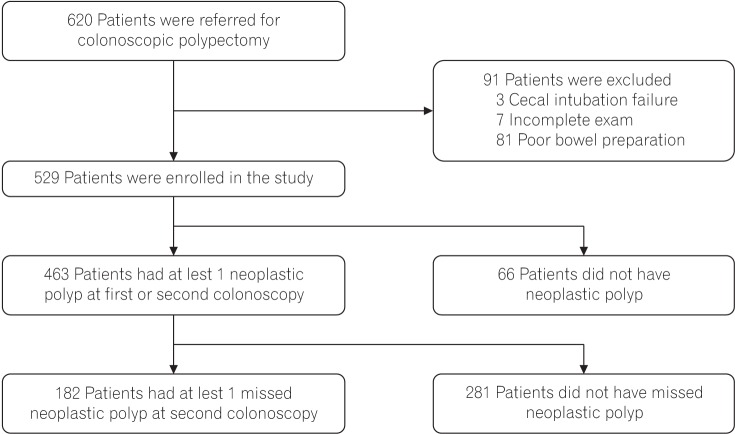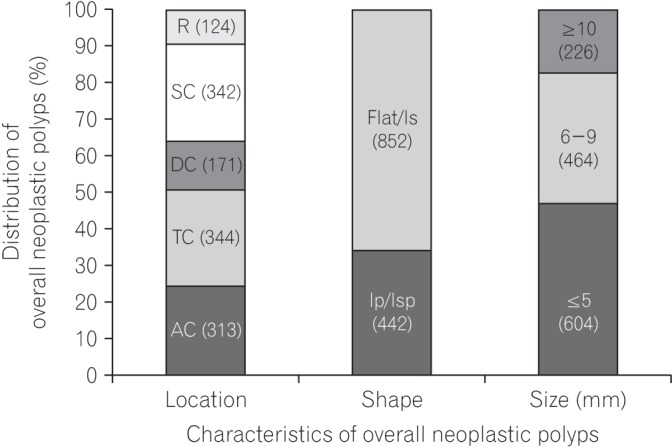Intest Res.
2017 Jul;15(3):411-418. 10.5217/ir.2017.15.3.411.
Miss rate of colorectal neoplastic polyps and risk factors for missed polyps in consecutive colonoscopies
- Affiliations
-
- 1Division of Gastroenterology, Department of Internal Medicine, Kangbuk Samsung Hospital, Sungkyunkwan University School of Medicine, Seoul, Korea. diksmc.park@samsung.com
- KMID: 2382386
- DOI: http://doi.org/10.5217/ir.2017.15.3.411
Abstract
- BACKGROUND/AIMS
Colonoscopic polypectomy is the best diagnostic and therapeutic tool to detect and prevent colorectal neoplasms. However, previous studies have reported that 17% to 28% of colorectal polyps are missed during colonoscopy. We investigated the miss rate of neoplastic polyps and the factors associated with missed polyps from quality-adjusted consecutive colonoscopies.
METHODS
We reviewed the medical records of patients who were found to have colorectal polyps at a medical examination center of the Kangbuk Samsung Hospital between March 2012 and February 2013. Patients who were referred to a single tertiary academic medical center and underwent colonoscopic polypectomy on the same day were enrolled in our study. The odds ratios (ORs) associated with polyp-related and patient-related factors were evaluated using logistic regression analyses.
RESULTS
A total of 463 patients and 1,294 neoplastic polyps were analyzed. The miss rates for adenomas, advanced adenomas, and carcinomas were 24.1% (312/1,294), 1.2% (15/1,294), and 0% (0/1,294), respectively. Flat/sessile-shaped adenomas (adjusted OR, 3.62; 95% confidence interval [CI], 2.40-5.46) and smaller adenomas (adjusted OR, 5.63; 95% CI, 2.84- 11.15 for ≤5 mm; adjusted OR, 3.18; 95% CI, 1.60-6.30 for 6-9 mm, respectively) were more frequently missed than pedunculated/sub-pedunculated adenomas and larger adenomas. In patients with 2 or more polyps compared with only one detected (adjusted OR, 2.37; 95% CI, 1.55-3.61 for 2-4 polyps; adjusted OR, 11.52; 95% CI, 4.61-28.79 for ≥5 polyps, respectively) during the first endoscopy, the risk of missing an additional polyp was significantly higher.
CONCLUSIONS
One-quarter of neoplastic polyps was missed during colonoscopy. We encourage endoscopists to detect smaller and flat or sessile polyps by using the optimal withdrawal technique.
MeSH Terms
Figure
Cited by 2 articles
-
Quality is the Key for Emerging Issues of Population-Based Colonoscopy Screening
Jin Young Yoon, Jae Myung Cha, Yoon Tae Jeen
Clin Endosc. 2018;51(1):50-55. doi: 10.5946/ce.2018.010.Quality is the key for emerging issues of population-based colonoscopy screening
Jin Young Yoon, Jae Myung Cha, Yoon Tae Jeen, ,
Intest Res. 2018;16(1):48-54. doi: 10.5217/ir.2018.16.1.48.
Reference
-
1. Winawer SJ, Zauber AG, Ho MN, et al. Prevention of colorectal cancer by colonoscopic polypectomy. The National Polyp Study Workgroup. N Engl J Med. 1993; 329:1977–1981. PMID: 8247072.
Article2. Zauber AG, Winawer SJ, O'Brien MJ, et al. Colonoscopic polypectomy and long-term prevention of colorectal-cancer deaths. N Engl J Med. 2012; 366:687–696. PMID: 22356322.
Article3. Brenner H, Chang-Claude J, Seiler CM, Hoffmeister M. Interval cancers after negative colonoscopy: population-based case-control study. Gut. 2012; 61:1576–1582. PMID: 22200840.
Article4. Bressler B, Paszat LF, Chen Z, Rothwell DM, Vinden C, Rabeneck L. Rates of new or missed colorectal cancers after colonoscopy and their risk factors: a population-based analysis. Gastroenterology. 2007; 132:96–102. PMID: 17241863.
Article5. Rex DK. Maximizing detection of adenomas and cancers during colonoscopy. Am J Gastroenterol. 2006; 101:2866–2877. PMID: 17227527.
Article6. Cha JM. Interval cancers after a negative colonoscopy finding in a Korean population: a small step for gastroenterologists but one giant leap for Koreans. Intest Res. 2014; 12:169–170. PMID: 25349587.
Article7. Barclay RL, Vicari JJ, Doughty AS, Johanson JF, Greenlaw RL. Colonoscopic withdrawal times and adenoma detection during screening colonoscopy. N Engl J Med. 2006; 355:2533–2541. PMID: 17167136.
Article8. Robertson DJ, Lieberman DA, Winawer SJ, et al. Colorectal cancers soon after colonoscopy: a pooled multicohort analysis. Gut. 2014; 63:949–956. PMID: 23793224.
Article9. van Rijn JC, Reitsma JB, Stoker J, Bossuyt PM, van Deventer SJ, Dekker E. Polyp miss rate determined by tandem colonoscopy: a systematic review. Am J Gastroenterol. 2006; 101:343–350. PMID: 16454841.
Article10. Shehadeh I, Rebala S, Kumar R, Markert RJ, Barde C, Gopalswamy N. Retrospective analysis of missed advanced adenomas on surveillance colonoscopy. Am J Gastroenterol. 2002; 97:1143–1147. PMID: 12014718.
Article11. Kasugai K, Miyata M, Hashimoto T, et al. Assessment of miss and incidence rates of neoplastic polyps at colonoscopy. Dig Endosc. 2005; 17:44–49.
Article12. Ahn SB, Han DS, Bae JH, Byun TJ, Kim JP, Eun CS. The miss rate for colorectal adenoma determined by quality-adjusted, back-to-back colonoscopies. Gut Liver. 2012; 6:64–70. PMID: 22375173.
Article13. Heresbach D, Barrioz T, Lapalus MG, et al. Miss rate for colorectal neoplastic polyps: a prospective multicenter study of back-to-back video colonoscopies. Endoscopy. 2008; 40:284–290. PMID: 18389446.
Article14. Leufkens AM, van Oijen MG, Vleggaar FP, Siersema PD. Factors influencing the miss rate of polyps in a back-to-back colonoscopy study. Endoscopy. 2012; 44:470–475. PMID: 22441756.
Article15. Hong SN, Sung IK, Kim JH, et al. The effect of the bowel preparation status on the risk of missing polyp and adenoma during screening colonoscopy: a tandem colonoscopic study. Clin Endosc. 2012; 45:404–411. PMID: 23251889.
Article16. Ferrández A, Navarro M, Díez M, et al. Risk factors for advanced lesions undetected at prior colonoscopy: not always poor preparation. Endoscopy. 2010; 42:1071–1076. PMID: 20960390.
Article17. Kim JH, Kim YS, Cheon JH, et al. Influence of the insertion time and number of polyps on miss rate in colonoscopy. Scand J Gastroenterol. 2011; 46:634–639. PMID: 21370993.
Article18. Pohl H, Robertson DJ. Colorectal cancers detected after colonoscopy frequently result from missed lesions. Clin Gastroenterol Hepatol. 2010; 8:858–864. PMID: 20655393.
Article19. Aronchick CA, Lipshutz WH, Wright SH, Dufrayne F, Bergman G. A novel tableted purgative for colonoscopic preparation: efficacy and safety comparisons with Colyte and Fleet Phospho-Soda. Gastrointest Endosc. 2000; 52:346–352. PMID: 10968848.
Article20. Ng SC, Tsoi KK, Hirai HW, et al. The efficacy of cap-assisted colonoscopy in polyp detection and cecal intubation: a meta-analysis of randomized controlled trials. Am J Gastroenterol. 2012; 107:1165–1173. PMID: 22664471.
Article21. Kondo S, Yamaji Y, Watabe H, et al. A randomized controlled trial evaluating the usefulness of a transparent hood attached to the tip of the colonoscope. Am J Gastroenterol. 2007; 102:75–81. PMID: 17100978.
Article22. Tsai FC, Strum WB. Prevalence of advanced adenomas in small and diminutive colon polyps using direct measurement of size. Dig Dis Sci. 2011; 56:2384–2388. PMID: 21318587.
Article23. Rex DK, Cutler CS, Lemmel GT, et al. Colonoscopic miss rates of adenomas determined by back-to-back colonoscopies. Gastroenterology. 1997; 112:24–28. PMID: 8978338.
Article24. Bianco MA, Cipolletta L, Rotondano G, et al. Prevalence of nonpolypoid colorectal neoplasia: an Italian multicenter observational study. Endoscopy. 2010; 42:279–285. PMID: 20235006.
Article
- Full Text Links
- Actions
-
Cited
- CITED
-
- Close
- Share
- Similar articles
-
- The Miss Rate for Colorectal Adenoma Determined by Quality-Adjusted, Back-to-Back Colonoscopies
- Importance of Early Follow-up Colonoscopy in Patients at High Risk for Colorectal Polyps
- The Colonoscopic Miss Rates of Colorectal Polyps as Determined by a Polypectomy
- Resection of Diminutive and Small Colorectal Polyps: What Is the Optimal Technique?
- Detection of Polyps After Resection of Colorectal Cancer



